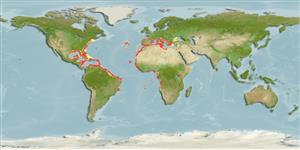Common names from other countries
Environment: milieu / climate zone / depth range / distribution range
Ecología
Bentopelágico; rango de profundidad 20 - 828 m (Ref. 8), usually 100 - 400 m (Ref. 8). Subtropical; 8°C - 15°C (Ref. 804), preferred 24°C (Ref. 107945); 48°N - 19°S, 98°W - 37°E
Atlantic and the Mediterranean: from USA to French Guiana, the entire Mediterranean and from Portugal to Namibia.
Length at first maturity / Tamaño / Peso / Age
Maturity: Lm 2.4, range 1 - 2.8 cm Max length : 16.0 cm TL macho / no sexado; (Ref. 8); 19 cm TL (female); common length : 14.0 cm TL macho / no sexado; (Ref. 8); common length :16 cm TL (female); edad máxima reportada: 3.00 años (Ref. 80253)
Demersal (Ref. 85316). Maximum depth range from Ref. 114857; minimum common depth from Ref. 80253. Maximum total length (female) from Ref. 104052 Prefers mud or muddy sand substrates (Ref. 8). Juveniles settle at around 100 m, though can be detected up to 300 m, while larger individuals are always found deeper than 350 m (Ref. 80253). Feeds on benthic organisms (clams, mysids and small crangonids; Ref. 434). Also occurs in pelagic depths between 100 to 200 m (Ref. 92299). Opportunistic predator (Ref. 112170).
The species has a life cycle of 2 to 3 years (Ref. 80253). Mating behavior: Precopulatory courtship ritual is common (through olfactory and tactile cues); usually indirect sperm transfer (Ref. 833).
Holthuis, L.B. 1980. (Ref. 8)
IUCN Red List Status (Ref. 130435)
CITES status (Ref. 108899)
Not Evaluated
Not Evaluated
Human uses
Pesquerías: comercial
FAO - pesquerías: landings, species profile | FIRMS (Stock assessments) | FishSource | Sea Around Us
Herramientas
Fuentes de Internet
Estimates based on models
Preferred temperature
(Ref.
115969): 9.4 - 19.5, mean 14 (based on 393 cells).
Resiliencia
Alto, población duplicada en un tiempo mínimo inferior a 15 meses (K=0.44-2; tm=0.6; tmax=3).
Prior r = 1.40, 95% CL = 0.92 - 2.10, Based on 15 full stock assessments.
Vulnerability
Low vulnerability (10 of 100).
